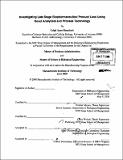| dc.contributor.advisor | Noubar Afeyan and Roy Welsch. | en_US |
| dc.contributor.author | Hunnicutt, Leigh Anne | en_US |
| dc.contributor.other | Leaders for Manufacturing Program. | en_US |
| dc.date.accessioned | 2008-12-11T18:35:57Z | |
| dc.date.available | 2008-12-11T18:35:57Z | |
| dc.date.copyright | 2008 | en_US |
| dc.date.issued | 2008 | en_US |
| dc.identifier.uri | http://hdl.handle.net/1721.1/43837 | |
| dc.description | Thesis (M.B.A.)--Massachusetts Institute of Technology, Sloan School of Management; and, (S.M.)--Massachusetts Institute of Technology, Biological Engineering Division; in conjunction with the Leaders for Manufacturing Program at MIT, 2008. | en_US |
| dc.description | MIT Institute Archives copy: pages, 85-86, 87-88, 89-90 bound in reverse order. | en_US |
| dc.description | Includes bibliographical references (p. 79-83). | en_US |
| dc.description.abstract | The biopharmaceutical industry uses recombinant protein technologies to provide novel therapeutics to patients around the world. These technologies have presented exciting opportunities for breakthrough medical treatments while creating a host of challenges in the discovery, development and manufacture of these products. Protein aggregation is one of the challenges currently limiting the ability to bring new biopharmaceutical products into the market and to manufacture existing commercial products. The mechanisms of aggregation and subsequent particle formation are highly complex, incompletely understood, and difficult to measure quantitatively with currently available analytical tools. Aggregates, and their effect on product appearance, may compromise value to the patient (bioavailability, dose, therapeutic activity and immunogenicity) as well as value to the company (yield loss and performance in a competitive marketplace) and are therefore tightly regulated. This thesis is intended to explore the problem of protein particles through two main avenues: meeting current regulatory criteria and influencing future regulation. Process changes, analytical characterization, and organizational improvements are each addressed to achieve that goal. An experiment was designed and completed to jointly examine (1) changes to manufacturing processes using novel filtration applications intended to reduce or remove protein particles from solution and (2) analytical tools for improved characterization. Organizational dynamics and resource allocation add an extra layer of complexity and are discussed in relation to leveraging knowledge regarding particles. | en_US |
| dc.description.abstract | (cont.) Additionally, three objectives are established to influence the direction of future regulation: the need for improved characterization, industry collaboration and a healthy interface with regulatory bodies. | en_US |
| dc.description.statementofresponsibility | by Leigh Anne Hunnicutt. | en_US |
| dc.format.extent | 90 p. | en_US |
| dc.language.iso | eng | en_US |
| dc.publisher | Massachusetts Institute of Technology | en_US |
| dc.rights | MIT theses may be protected by copyright. Please reuse MIT thesis content according to the MIT Libraries Permissions Policy, which is available through the URL provided. | en_US |
| dc.rights.uri | http://dspace.mit.edu/handle/1721.1/7582 | en_US |
| dc.subject | Sloan School of Management. | en_US |
| dc.subject | Biological Engineering Division. | en_US |
| dc.subject | Leaders for Manufacturing Program. | en_US |
| dc.title | Investigating late stage biopharmaceutical product loss using novel analytical and process technology | en_US |
| dc.type | Thesis | en_US |
| dc.description.degree | S.M. | en_US |
| dc.description.degree | M.B.A. | en_US |
| dc.contributor.department | Leaders for Manufacturing Program at MIT | en_US |
| dc.contributor.department | Massachusetts Institute of Technology. Department of Biological Engineering | |
| dc.contributor.department | Sloan School of Management | |
| dc.identifier.oclc | 262697848 | en_US |
